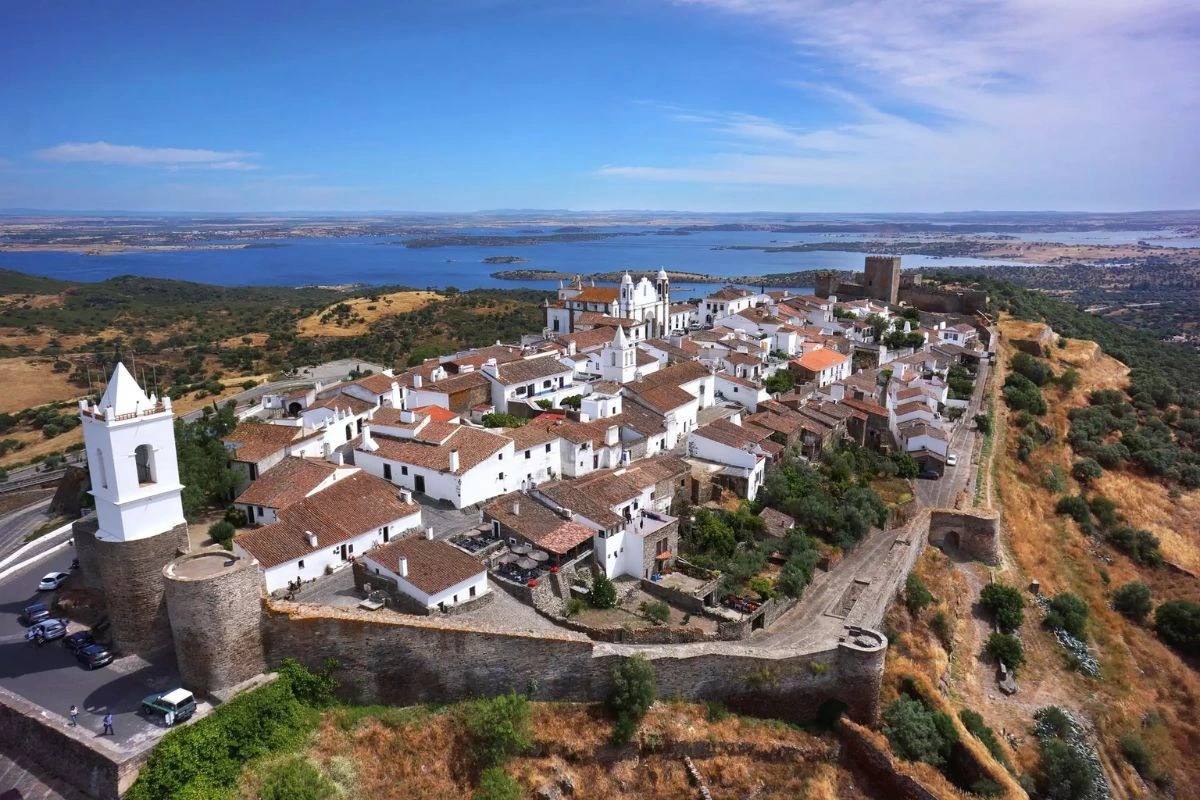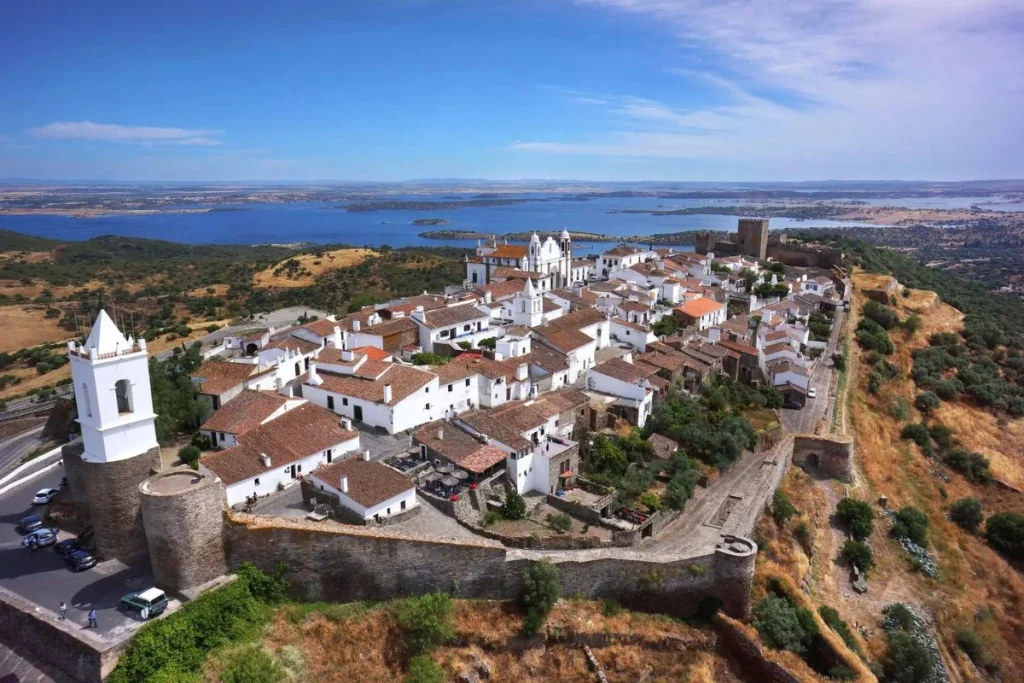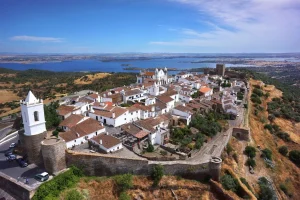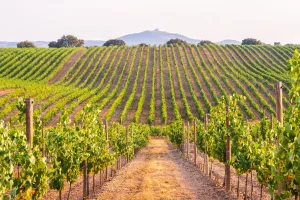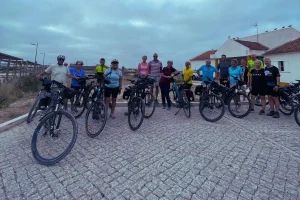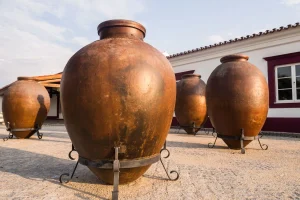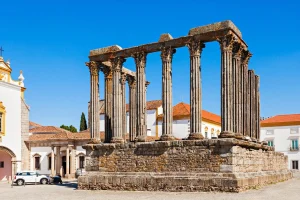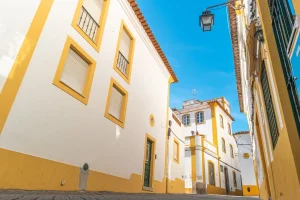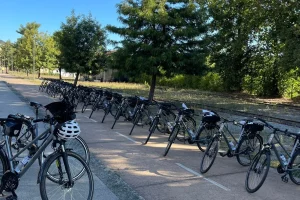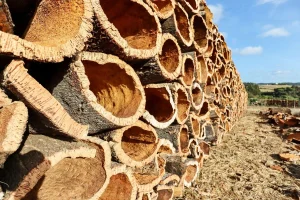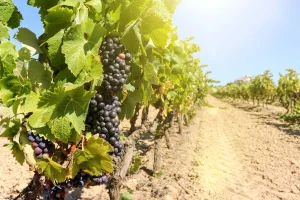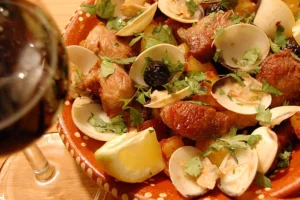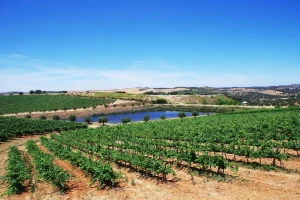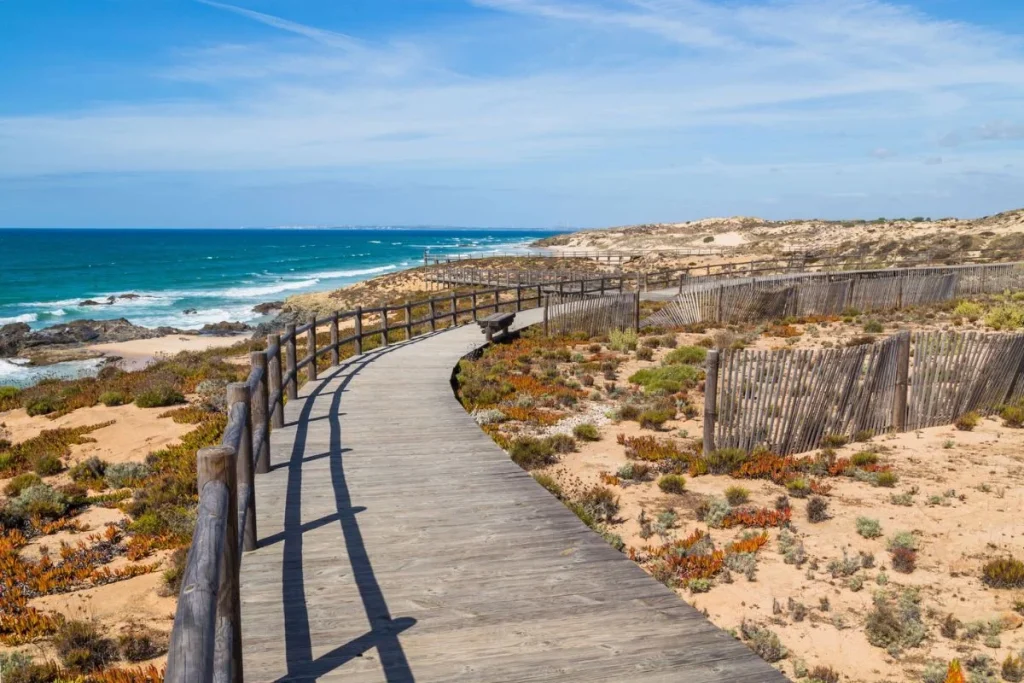- Overview
- Tour Outline
- Tour Includes
- Tour Excludes
- Gallery
- Booking
Immerse in the charm of Alentejo as you cycle through picturesque villages, vineyards, and olive groves, indulging in delicious cuisine and fine wines. Explore Alentejo's breathtaking landscapes and rich cultural heritage on our guided premium bike tour.
Duration: 8 days / 7 nights
Highlights
- Évora: Discover the historic city of Évora, a UNESCO World Heritage Site, with its ancient streets, Roman ruins, and magnificent palaces.
- Monsaraz, a fortified village perched atop a hill, offering stunning panoramic views of the Alentejo plains.
- The national stud farm, breeding ground of the Pure Lusitano Horse
- Marble - Portugal, the world's largest producer
- Rich traditional Cuisine - delight your taste buds with authentic Alentejo gastronomy, savouring migas, lamb stew, and artisanal cheeses.
- Family-owned wineries where you will savour award-winning wines while learning about Alentejo's traditional winemaking methods.
- Alqueva - the largest artificial water reservoir in Europe
- Unspoiled nature - cycle through tranquil countryside roads bordered by golden fields, ancient olive trees, and cork oak forests, immersing yourself in the pristine nature of the region.
Note: This premium tour is designed to provide maximum comfort and exclusive experiences. Group sizes are limited to ensure personalized service.
About this tour
Your tour of one of Portugal's most characteristic regions - the Alentejo - will take you to its plains, towns and villages, painted white, welcoming visitors with the same warmth as their inhabitants.
Here, the landscapes follow the rhythm of the seasons; the agricultural fields and the cork oaks shelter the region's typical livestock from both the sun and the cold and give fame to the gastronomic specialities that are so rich and so characteristic of this region.
The traces of history are very much present in the places this tour passes, and you can quickly learn about the spoils and monuments scattered around various locations. Let yourself be dazzled by the Roman Temple of Diana or the Cathedral, both in Évora, the star-shaped wall of Elvas or the prehistoric remains in the direction of Beja.
The palate also celebrates the passage through the Alentejo, the authentic flavours, rich in identity, both in the wines, with diverse grape varieties and easily harmonized with the most typical dishes, which are so delicious that we forget their origins at a time when poverty forced the reinvention of many dishes.
Be inspired by the calm of the places you visit and their people, and take the opportunity to relax in contemplation of nature.
No details found.
Itineraries
Day 1
Transfer In to Vendas Novas
This Alentejo Bike Tour Guided Premium starts with the arrival at Lisbon Airport and transfer to the Hotel in Vendas Novas.
Day 2 | Stage 1
Vendas Novas to Évora
Vendas Novas owes its origin and importance to the construction of the road to the Alentejo by King João V, who, heading for the Spanish border for the famous episode of the "Troca das Rainhas" Exchange of Queens, chose this town to build the "Palácio das Passagens" (Palace of Passages), now converted into an Artillery Regiment.
Before leaving Vendas Novas, we suggest one of the region's most emblematic delicacies - Bifanas de Vendas Novas - a "simple pork steak on bread", the secret of which is said to be in the sauce.
Let yourself be guided through the Alentejo countryside and head for Montemor-o-Novo, where the Medieval Castle will guide you from the top of the hill. Here, details were finalised for Vasco da Gama's sea voyage to India.
Your route to Évora continues, stopping for a few minutes at kilometre 70 to admire the Twin Holm oaks (a natural phenomenon in which two trees grow next to each other and their tops become one).
Take the opportunity to glide along to the rhythm of the Alentejo breeze and enjoy the scenery.
Welcome to one of the Unesco World Heritage cities, whose history is lost in time. The range of monuments is extensive and diverse, and its ex-libris include the Sé Cathedral, the most significant medieval cathedral in the country; the Roman Temple of Diana; and the Chapel of Bones.
As for palate delights, the black pig is king here, usually accompanied by the typical Alentejo migas (breadcrumbs).
Day 3 | Stage 2
Évora to Alter do Chão
We leave Évora behind and dive into the authentic identity of the Alentejo. Today's stage is characterized by the Alentejo's trademark - plains, where the brown of the land is brushed by the green of the cork oaks and olive trees, from where to where a group of cattle take advantage of a leftover tree, awaiting the arrival of the coolness of the evening.
Your route takes you to Alter do Chão, a quiet village with cobbled streets and typical white houses with orange façades painting the town centre in the colours of the Alentejo.
The origins of this town are lost in time, dating back to the Roman presence on the Iberian Peninsula, where the military route linking Lisbon to Mérida passed through.
There are many monuments here, but the most symbolic is undoubtedly the National Stud Farm, founded in 1748 by King João V to breed Lusitano horses for the Royal Stud Farm. Among the various services available here, part of the space has been converted into accommodation that allows you to have a unique immersive experience in the equestrian arts and the critical art of falconry, the ancient art of training and hunting birds of prey.
Here, soups are a delicacy, whether it's tomato, dogfish, açordas, or even Spanish influences with a flavoursome Alentejo gazpacho. All this goes very well with a wine from the region, which creates unique terroir conditions thanks to the micro-climate of north-eastern Alentejo and the soil characteristics.
Vicentine Coast Natural Park: Odemira is part of the Vicentine Coast Natural Park, offering pristine landscapes, diverse ecosystems, and stunning cliffs along the Atlantic coastline.
Almograve Beach: This picturesque beach near Odemira is known for its golden sands, clear waters, and scenic surroundings. It's an excellent spot for relaxation and seaside walks.
Historic Center of Odemira: Explore the charming historic centre of Odemira, characterized by traditional whitewashed buildings, cobbled streets, and a relaxed atmosphere.
Santa Clara-a-Velha: a medieval monastery near Odemira, providing a glimpse into the region's historical and architectural heritage.
Santa Clara Dam: The Santa Clara Dam, also known as Barragem de Santa Clara, is a tranquil reservoir surrounded by hills and greenery. It's a serene location for picnics and enjoying nature.
Zambujeira do Mar: A charming coastal village near Odemira, Zambujeira do Mar is known for its beautiful beaches, the annual music festival (Festival do Sudoeste), and stunning sunsets.
Rota Vicentina: The Rota Vicentina is a network of biking and walking trails that pass through the region, allowing visitors to explore the natural beauty and rural landscapes of the region's allure, natural landscapes, and cultural richness
Day 4 | Stage 3
Alter do Chão to Elvas
Today's route maintains the same scenery as the previous day, with the Alentejo plains as a backdrop. Along the way, you'll get to know some of the region's typical landmarks up close, passing through some localities with their castles, houses and specific features. As you pass Castelo de Vide, take the opportunity to cool off in the Sulfurea Thermal Baths, which date back to Roman times and are considered a reference point for rheumatic, respiratory and skin diseases.
Before you reach your destination, stop to see the typical Santo Aleixo puppets, marionettes supported by a double network of strings, which tell stories against a backdrop of painted cardboard and lit by oil lamps. The shows are performed to the sound of the Portuguese guitar.
Elvas, the border town between Portugal and Spain, is easily identified by its walls, which have been classified as a UNESCO World Heritage Site since 2012. This complex of walls, the largest in the world in the type of land-based bastioned fortifications, with a perimeter of around 9 kilometres, which covers the entire town, had the primary function of protecting it from any attacks that might come from neighbouring Spain. An imposing aqueduct complex was added to the walls to guarantee greater autonomy in siege situations.
You can't miss out on one of Elvas' most typical sweets - its plums in syrup, which the Fábrica-Museu Ameixas de Elvas, founded in 1919, still uses today, using the original recipe from the 16th-century convents. You can also enjoy the plums with a slice of sericaia, the flavours of a region bursting in your mouth.
Day 5 | Stage 4
Elvas round tour
The region's richness motivates a circular tour, with visits to some Alentejo villages where authenticity is a banner.
Visit the town of Borba and get lost in its streets and the friendliness of its people. Here, wine and marble stone are the hallmarks. The soul of Alentejo wines also knows its origins here, guaranteeing the region's flavour in every glass.
The region's internationally renowned marble embellishes both private buildings and monuments. You can learn a little about exploiting this raw material with a visit to the Marble Theme Park.
Continuing your tour towards Vila Viçosa, you must pass by the Paço Ducal, the residence of the Dukes of Bragança, who began the fourth and last dynasty of the Portuguese monarchy. The Mannerist façade is entirely clad in the region's most typical and noble stone - marble.
Discover the region, let yourself get lost on the cycle paths and enjoy the calm of the Alentejo to recover your energy.
Day 6 | Stage 5
Elvas to Monsaraz
This tour continues today with the Guadiana River as his companion, now alongside the Spanish border. Heading south, there are several reservoirs and dams, many of which result from the Alqueva Dam - with more than 1100 kilometres of banks, it is the largest artificial lake in Europe. This dam is today the most significant water reserve in the country. It provides enough electricity to supply the entire district of Beja.
Along the way, you'll quickly discover some of the remains that mark these people's time. You'll cross the Guadiana River by the Ribeira de Pêga Roman Bridge, and there are many megalithic and funerary monuments along the path – Cromeleque do Xerez and Menir da Bulhoa.
Once you arrive in Monsaraz, a medieval walled town, appreciate the authenticity of this true soul of the Alentejo. Here, the streets are cobbled, and the houses are whitewashed to ensure coolness on the hottest summer days.
Olive oil has museum privileges, and Cante Alentejano has a house named after it, a space that aims to promote, exalt and study Cante Alentejano; this space seeks to promote and study. UNESCO declared Cante Alentejano an Intangible Cultural Heritage of Humanity in 2014.
The sunset over the Alqueva will be one of the most impressive images you'll take away from your trip.
Day 7 | Stage 6
Monsaraz to Beja
On your last day of touring the Alentejo, part of your route will be guided by the Alqueva Dam and the Guadiana River. The water mirrors, and the freshness that comes from them will set the pace for your day.
Now the landscape is changing, the green is dappling the horizon, but the cork oaks insist on being part of this picture, as well as the countless archaeological remains, living testimonies of the Roman and Arab presence, and for proof we have the original name of Beja - Pax Julia.
With its architectural heritage in excellent preservation, your stroll through Beja's city centre will show you the best examples of architectural evolution over the centuries, from the Roman Castle to the Convent of Nossa Senhora da Conceição and the cathedral.
Once you've got the Alentejo's most breathtaking landscapes in your mind, make sure your five senses are complete by sampling some of the region's delicacies - here you'll find lamb stew, broad beans stewed with sausages and black pork, often accompanied by migas. Perfection will come with the choice of wine from the region, which gives Alentejo wines distinctive flavour thanks to a unique and special climate and typical soil.
Day 8 | Transfer Out
Transfer Out to Lisbon Airport
Transfer Out to Lisbon Airport
- Organization of the program
- 5 picnic per person
- 2 dinners at estates
- Accommodation carefully selected, offering comfort and hospitality typical of Alentejo.
- High-quality bikes and safety equipment for a smooth and enjoyable cycling experience.
- Knowledgeable guides provide cultural insights and assistance throughout the tour.
- Gourmet meals are showcasing local flavours and fresh, seasonal ingredients.
- Luggage transfer between destinations for a hassle-free journey.
- Wine tastings at selected wineries to explore the rich oenological tradition of Alentejo.
- Transfer from the airport to the first accommodation and from the last accommodation to the airport, included
- Overnight storage of bicycles at the hotels
- Meals, wine experiences and cooking experience (optional)
- Helmet (on request)
- Travel Insurance. We do suggest: Nomads / Worldwide / Colombus
- Personal expenses
- Other items not mentioned
- Mechanical bike interventions made on the bikes without Pedalquest Tours' permission
- The damages caused by bad use or accident are the client’s responsibility and so the cost associated will be charged directly to them (However, Pedalquest Tours will provide assistance for the situation to be resolved in the clients’ best interest)
- Small repairs such as a tire repair or inner tube change are done by clients. For that, we provide 1 toolkit per group with the necessary gear
Please note: Clients are advised to bring their own helmets, although we can provide a limited number of second-hand helmets, if required, at no extra charge. Clients may purchase a brand-new helmet from us for an additional 80 euros. If required, these must be requested when booking your journey, otherwise we cannot guarantee availability.

